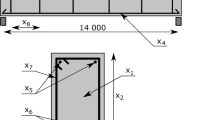Abstract
This paper presents the reliability levels provided by the load-resistance factors of the AASHTO LRFD Bridge Design Specifications for the Strength Limit State-I and -IV, and an optimization scheme for adjusting the load-resistance factors of the specifications. It is shown that the load-resistance factors of the specifications result in lower reliability indices than the target reliability index and widely varying reliability indices with the load composition for reinforced concrete, steel and pre-stressed concrete members. An optimization scheme is proposed to obtain a new set of the load-resistance factors that yield more uniform reliability levels and better approximation to the target reliability index in a wide range of load compositions. The objective function of the proposed optimization scheme is defined as the L2-norm of the error between the target and calculated reliability indices by load-resistance factors over a given interval of load composition. The results of the optimization show that the dead load factor for structural components should be increased by 0.1 for the Strength Limit State-I, and that the vehicular live load should be included in the Strength Limit State-IV. The use of exact figures up to the second decimal point is recommended for the resistance factors. A unified limit state for gravitational loads is proposed to replace the two limit states with a single limit state.
Similar content being viewed by others
References
AASHTO (American Association of State Highway and Transportation Officials). (2014). AASHTO LRFD Bridge Design Specifications, Washington, DC.
CEN (European Committee for Standardization). (2002). Eurocode 0: Basis of Structural Design EN 1990.
Ellingwood, B. R., Galambos, T. V., MacGregor, J. G., and Cornell, C. A. (1980). Development of a Probability Based Load Criterion for American National Standard A58, Washington, DC: National Bureau of Standards.
Ellingwood, B., MacGregor, J. G., Galambos, T. V., and Cornell, C. A. (1982). “Probability based load criteria: Load factors and load combinations.” J. Struct. Div., ASCE, Vol. 108, No. 5, pp. 978–997.
Gayton, N., Mohamed, A., Sørensen, J. D., Pendola, M., and Lemaire, M. (2004). “Calibration methods for reliability-based design codes.” Sturct. Safety, Vol. 26, pp, 91–121, DOI: 10.1016/S0167-4730(03)00024-9.
Haldar, A. and Mahadevan, S. (2000). Probability, Reliability and Statistical Methods in Engineering Design, John Wiley & Sons, Inc., New York, pp. 181–224.
ISO (International Organization for Standardization). (1998). International Standard ISO 2394: General principles on reliability for structures, Switzerland.
Kohler, J. and Fink, G. (2012). “Reliability based code calibration of typical Eurocode 5 design equations.” World Conf. Timber Eng., 4, 99–103.
MacGregor, J. G., Kennedy, D. J. L., Bertlett, F. M., Chernenko, D., Maes., M. A., and Dunaszegi, L. (1997). “Design criteria and load and resistance factors for the confederation bridge.” Can. J. Civ. Eng., Vol. 24, pp. 882–897, DOI: 10.1139/cjce-24-6-882.
Nowak, A. S. (1995). “Calibration of LRFD bridge code.” J. Struct. Div., ASCE, Vol. 121, No. 8, pp. 1245–1251, DOI: 10.1061/(ASCE)0733-9445(1995)121:8(1245).
Nowak, A. S. and Lind, N. C. (1979). “Practical bridge code calibration.” J. Struct. Div., ASCE, Vol. 105, No. 12, pp. 2497–2510.
Nowak, A. S. (1999). “Calibration of LRFD bridge design code.” NCHRP Report 368, Transportation Research Board, Washington, D.C.
Rackwitz, R. and Fiessler, B. (1978). “Structural reliability under combined random load sequences.” Comput. Struct., Vol. 9, No. 5, pp. 489–494.
Siu, W. C., Parimi, S., and Lind, N. C. (1975). “Practical approach to code calibration.” J. Struct. Div., ASCE, Vol. 101, No. 7, pp. 1469–1480.
Sørensen, J. D., Kroon, I. B., and Faber, M. H. (1994). “Optimal reliabilitybased code calibration.” Struct. Safety, Vol. 15, pp. 197–208, DOI: 10.1016/0167-4730(94)90040-X.
Author information
Authors and Affiliations
Corresponding author
Rights and permissions
About this article
Cite this article
Lee, H.S., Bae, C. & Kim, J.H. Assessment of Reliability Levels and Adjustment of Load-resistance Factors Using Optimization for Gravitational Loads-governed Limit States of the AASHTO LRFD Bridge Design Specifications. KSCE J Civ Eng 22, 3462–3472 (2018). https://doi.org/10.1007/s12205-017-0500-6
Received:
Accepted:
Published:
Issue Date:
DOI: https://doi.org/10.1007/s12205-017-0500-6




